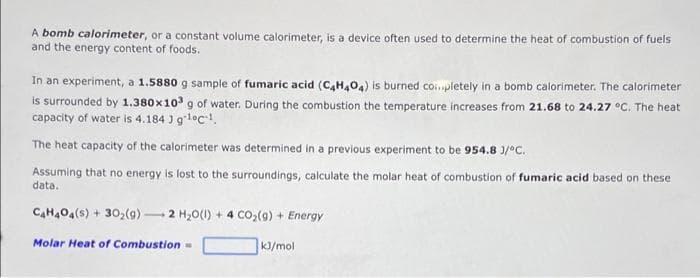A bomb calorimeter, or a constant volume calorimeter, is a device often used to determine the heat of combustion of fuels and the energy content of foods. In an experiment, a 1.5880 g sample of fumaric acid (C4H404) is burned completely in a bomb calorimeter. The calorimeter is surrounded by 1.380x10³ g of water. During the combustion the temperature increases from 21.68 to 24.27 °C. The heat capacity of water is 4.184 ) g1¹ec1. The heat capacity of the calorimeter was determined in a previous experiment to be 954.8 1/°C. Assuming that no energy is lost to the surroundings, calculate the molar heat of combustion of fumaric acid based on these data. C₂H4O4(s) + 30₂(g) 2 H₂O(l) + 4 CO₂(g) + Energy Molar Heat of Combustion = kJ/mol
A bomb calorimeter, or a constant volume calorimeter, is a device often used to determine the heat of combustion of fuels and the energy content of foods. In an experiment, a 1.5880 g sample of fumaric acid (C4H404) is burned completely in a bomb calorimeter. The calorimeter is surrounded by 1.380x10³ g of water. During the combustion the temperature increases from 21.68 to 24.27 °C. The heat capacity of water is 4.184 ) g1¹ec1. The heat capacity of the calorimeter was determined in a previous experiment to be 954.8 1/°C. Assuming that no energy is lost to the surroundings, calculate the molar heat of combustion of fumaric acid based on these data. C₂H4O4(s) + 30₂(g) 2 H₂O(l) + 4 CO₂(g) + Energy Molar Heat of Combustion = kJ/mol
Chemistry: Principles and Reactions
8th Edition
ISBN:9781305079373
Author:William L. Masterton, Cecile N. Hurley
Publisher:William L. Masterton, Cecile N. Hurley
Chapter8: Thermochemistry
Section: Chapter Questions
Problem 88QAP: A sample of sucrose, C12H22O11, is contaminated by sodium chloride. When the contaminated sample is...
Related questions
Question
100%

Transcribed Image Text:A bomb calorimeter, or a constant volume calorimeter, is a device often used to determine the heat of combustion of fuels
and the energy content of foods.
In an experiment, a 1.5880 g sample of fumaric acid (C4H404) is burned completely in a bomb calorimeter. The calorimeter
is surrounded by 1.380x10³ g of water. During the combustion the temperature increases from 21.68 to 24.27 °C. The heat
capacity of water is 4.184 ) g1c¹.
The heat capacity of the calorimeter was determined in a previous experiment to be 954.8 J/°C.
Assuming that no energy is lost to the surroundings, calculate the molar heat of combustion of fumaric acid based on these
data.
C₂H4O4(s) + 30₂(g) 2 H₂O(1) + 4 CO₂(g) + Energy
Molar Heat of Combustion =
kJ/mol
Expert Solution
This question has been solved!
Explore an expertly crafted, step-by-step solution for a thorough understanding of key concepts.
Step by step
Solved in 2 steps with 2 images

Knowledge Booster
Learn more about
Need a deep-dive on the concept behind this application? Look no further. Learn more about this topic, chemistry and related others by exploring similar questions and additional content below.Recommended textbooks for you

Chemistry: Principles and Reactions
Chemistry
ISBN:
9781305079373
Author:
William L. Masterton, Cecile N. Hurley
Publisher:
Cengage Learning

Chemistry: An Atoms First Approach
Chemistry
ISBN:
9781305079243
Author:
Steven S. Zumdahl, Susan A. Zumdahl
Publisher:
Cengage Learning


Chemistry: Principles and Reactions
Chemistry
ISBN:
9781305079373
Author:
William L. Masterton, Cecile N. Hurley
Publisher:
Cengage Learning

Chemistry: An Atoms First Approach
Chemistry
ISBN:
9781305079243
Author:
Steven S. Zumdahl, Susan A. Zumdahl
Publisher:
Cengage Learning


Chemistry by OpenStax (2015-05-04)
Chemistry
ISBN:
9781938168390
Author:
Klaus Theopold, Richard H Langley, Paul Flowers, William R. Robinson, Mark Blaser
Publisher:
OpenStax

Chemistry: Principles and Practice
Chemistry
ISBN:
9780534420123
Author:
Daniel L. Reger, Scott R. Goode, David W. Ball, Edward Mercer
Publisher:
Cengage Learning

Chemistry
Chemistry
ISBN:
9781305957404
Author:
Steven S. Zumdahl, Susan A. Zumdahl, Donald J. DeCoste
Publisher:
Cengage Learning